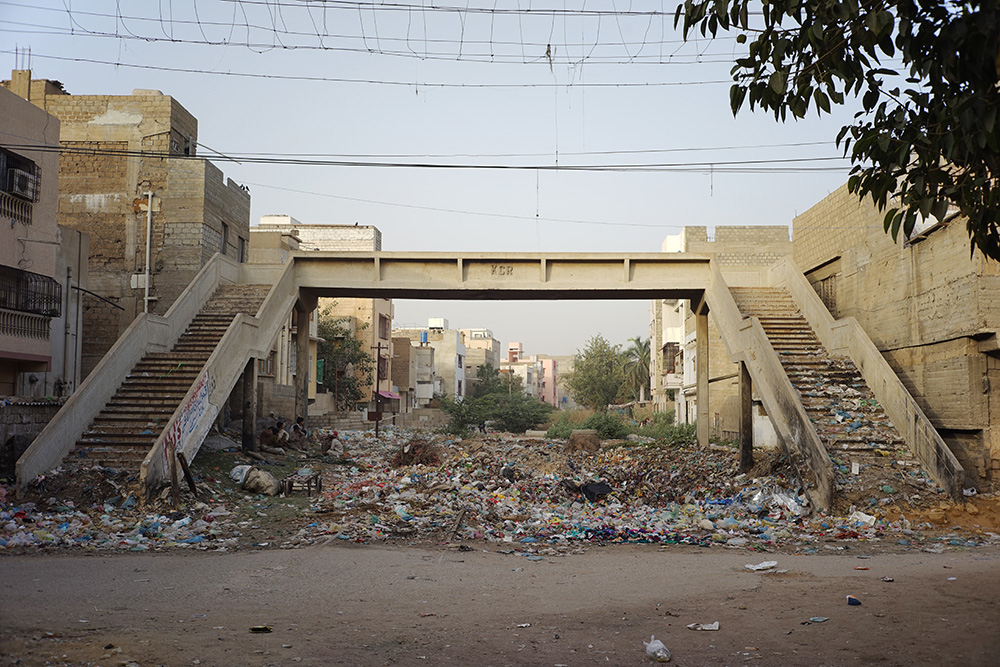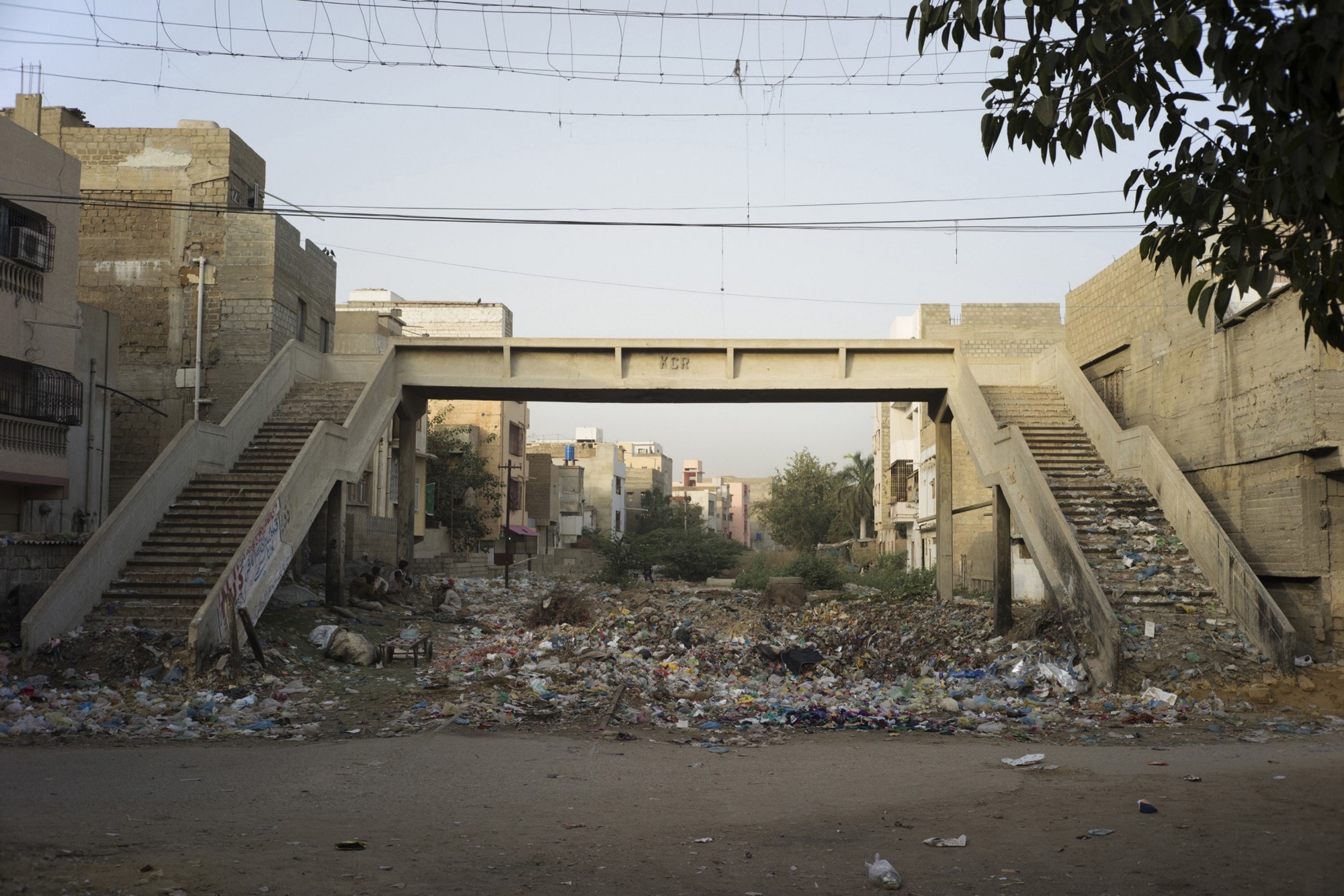
Karachi is a city with a bad reputation, with thousands of deaths reported each year. When compared with Chicago, which reports annual murders in the hundreds, it’s easy to see why Karachi is counted as the most violent city in Pakistan. But like all cities, the reality of Karachi is much more complex than the headlines suggest.
Karachi also holds a historical role as a safe harbor. Hundreds of thousands of Mujahirs arrived from India after Partition; internal migrants from Sindh and Balochistan moved there during successive waves of industrialization and urbanization; refugees escaped civil wars in East Pakistan/Bangladesh and Afghanistan; Pashto communities from FATA and the Northwest fled the disorder of the counter-terrorism wars. Hardship anywhere, after all, emerges at the intersection of geographical, political, social, and resource-related issues, the nuances of which are often swept up in a sensationalist media narrative.
Ivan Sigal sought to unpack the multilayered realities of life in Karachi, via a unique physical legacy leftover from a more optimistic time.
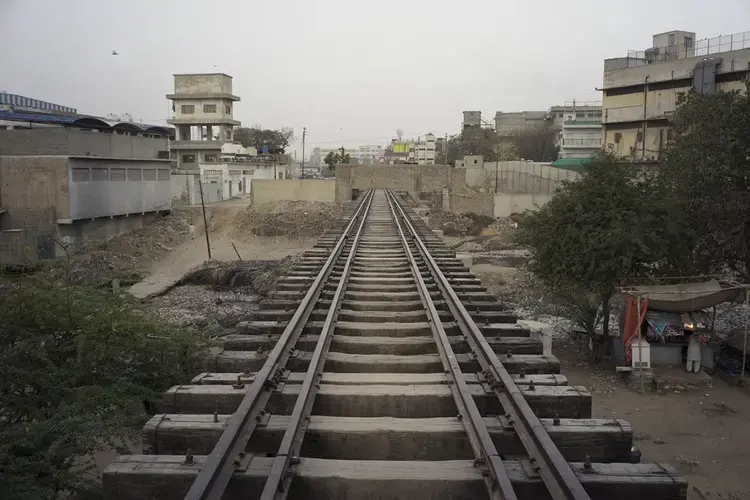
The Karachi Circular Railway began operations in 1969, part of a vision to provide modern ease of movement to a fast-growing city. In its first year of operation, the KCR carried some 6 million people. But over the decades, a mix of poor management, corruption, and increasing insecurity in the city led to a gradual decline of train service. The KCR closed in 1999, and since then it has dwindled to a ghostly outline of its former self, its overgrown corridors running through a diverse cross-section of Karachian life.
In 2014, Sigal walked the KCR’s entire 43 km length. Along the way, he documented what he saw in a variety of media forms: drone footage, photos, stationary video, writing, and field recordings. Sigal draws these visual and textual elements together in multi-channel, computer-controlled video installations, creating a randomized journey through the places and impressions gathered along the tracks.
The result is a kaleidoscopic impression of fluidity and complexity, a visual subversion of the standard narrative — indeed of almost any narrative — one might try to apply to the place. The ghostly lines of the defunct railway are overlapped by the vibrant life of the city it was meant to serve. The images and the way of life they reveal are not consistent with the headlines that shape many people’s impression of this conflicted metropolis.
Now on display at Ryerson Image Center in Toronto, Sigal’s KCR work can be seen as part of the exhibition Collaboration. A Potential History of Photography. Vantage spoke with Sigal to learn about how and why the project came to be.
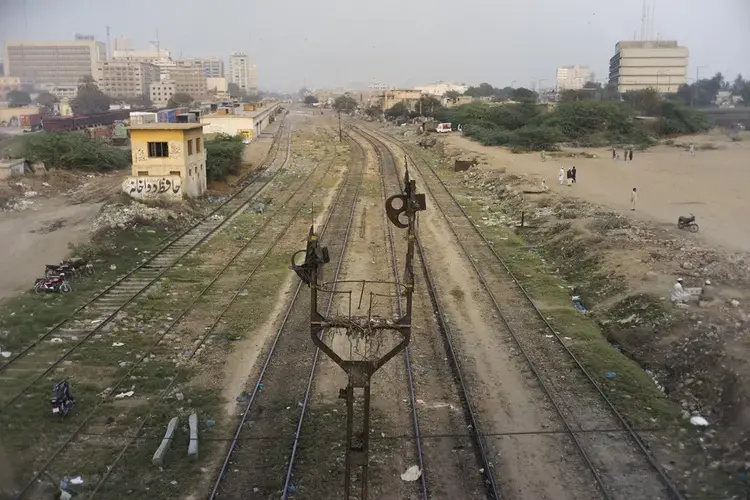
Vantage: The KCR seems to represent a vision of optimism, yet also a sort of negative space against which life in the city can be considered. Can you unpack some of what you see in the remnants of the KCR, in real or symbolic terms?
Ivan Sigal: The territory of the railway has a curiously liminal character. It is still public land, owned by Pakistan Railways, which means that there are formal restrictions as to what can happen on it. At the same time, in every location around the city, elements of neighboring communities seep into or actively encroach upon the railway’s territory.
In some places, people have occupied parts of the railway’s land, building both temporary shelters and permanent housing or businesses, establishing markets, cricket fields, and transport shortcuts. Elsewhere it’s returned to nature, becoming a field of acacia thorns, or reeds, or wetlands.
In all this, the structures of the railway remain: footbridges, stations and platforms, shelters, tracks, switching lights, even though they barely seem to be noticed by the people occupying or passing through. It’s not a subject really worthy of comment on a daily basis, but rather has become so familiar as to be invisible.
V: What does life along the KCR reveal about Karachi that standard media narratives miss? What is at stake in correcting that narrative?
IS: The railway was created as a transport element for a rational urban plan, with suburban neighborhoods linked to areas of commerce, manufacturing, and the city’s port. Behind that was an idea for an open city, a city accessible to all its residents, just as Pakistan was imagined as a country to be open to all its citizens. Its failure is also a failure of that vision.
The underlying reasons for its failure have to do with the state’s inability to manage successive waves of migration into the city, and the informal processes by which neighborhoods were established, gained access to resources, and created security for themselves.
In many cases, newly arrived migrants received access to land and utilities and protection from groups affiliated with political parties, who in turn recruited these communities into their political blocs and voter rolls. This patronage created exclusive zones across the city, primarily available to the main ethnic, communal, or linguistic communities in each area, and inflaming tensions between them that are too often accompanied by violence.
That narrative, of the sources of conflict in Karachi and the incentives people have to pursue violence, is quite different from mass media depictions of Karachi as a city overwhelmed by crime, terror and counter-terror. It places our understanding of conflict in relationship to structural issues — access to resources, to land, to opportunity for whole communities, instead of in relationship to personal narratives — groups of criminals or terrorists who mindlessly kill for base desires.
V: A video component of KCR was displayed as part of a public art installation in Karachi called Numaish Karachi in 2015. Then, it was largely a statement to the city itself. How is the presentation at Ryerson different in terms of form, and message to an audience outside of Karachi?
IS: I’ve shown the work at a variety of venues over the past three years, from the Fogg Museum at Harvard University to grassroots film festivals in Varanasi and Kolkuta, to film and arts festivals in Europe and North America. In many cases I’ve adapted the piece to the circumstances available, and that’s true for the Ryerson as well.
I’m interested in how we build narrative structures, in associating image and text through sequencing or randomization, and in how one might adapt narratives for different audiences and displays. The original design of the work was a nine-channel installation. There is also a single-channel option that captures much of the same flavor and doesn’t require the same level of technical support. In Karachi, I showed the single-channel version, while for the Ryerson I was able to adapt the nine-channel for a digital media wall.
I hope that the two presentations are saying similar things. How they are received is a different matter, of course. That said, the reactions thus have all been about the work’s focus on the anti-dramatic and quotidian, and resistance to romanticizing tropes and claims.
V: How did you first become interested in the KCR? Can you speak a bit to the experience of walking its entire 43 km length?
IS: I first began traveling to Karachi in 2001. I had been living in post-Soviet Central Asia for several years, and was beginning to work in Afghanistan. In 2003, Pakistan deregulated its media systems, opening the way for non-state radio and television. Over the next decade I spent a lot of time working with Pakistani media on everything from regulation and law to journalism production and training, to humanitarian information programming for communities in need due to natural disasters and conflict.
Throughout that time, Karachi was more a waypoint than a focus for me, but I was always fascinated by its rhythms and its scale. I was also spending time working on a photographic project about new urban landscapes in Asia, and was photographing all around Asia. And again, Karachi was an intriguing, dynamic place.
KCR came into focus for me as I began thinking more specifically about representing structural violence, and to describe the effects of war through narratives other than the standard depictions of soldiers shooting weapons, of military hardware, of frontline reporting. In KCR I found a way to imagine an alternative future for Karachi. The decision to walk its circumference was a way to ask questions of the space, to conduct an open-ended investigation into how Karachi’s residents actually move through the city, and how they use the space of the railway today.
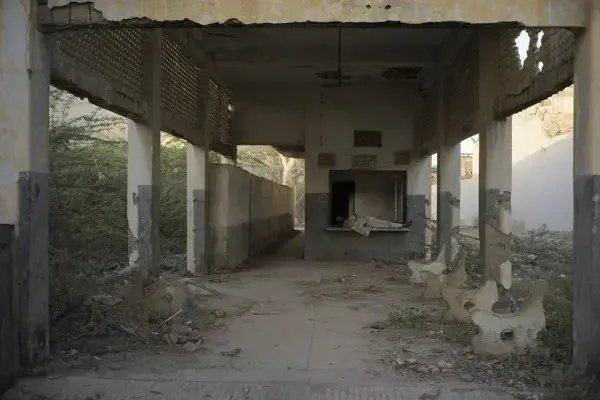
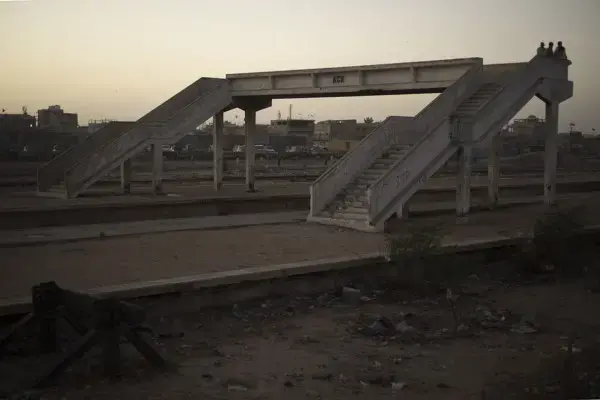
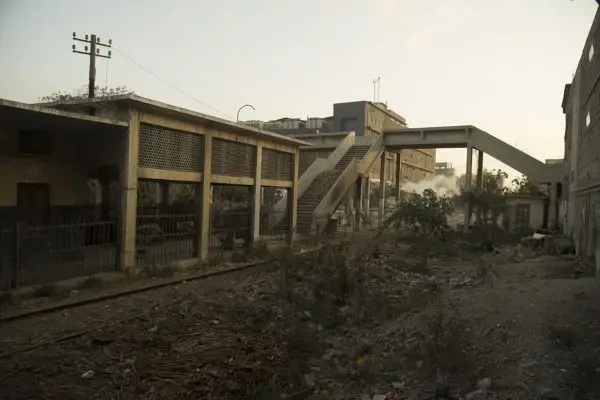
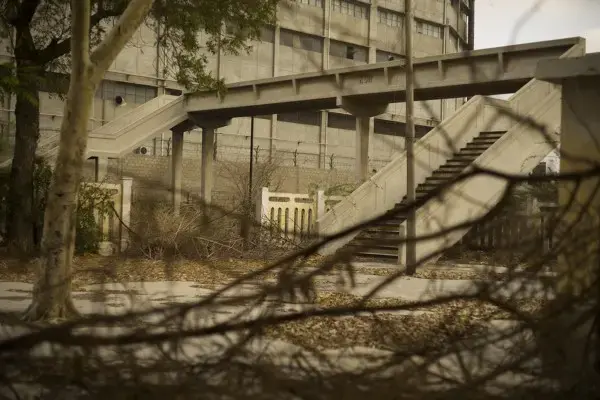
V: KCR incorporates photography, ground and aerial photography, layered editing, multichannel video, algorithms for sequencing, a substantial body of original writing, and a number of other techniques. What led you to the various tools and methods used to document and present this work?
IS: In thinking about narrative structure and aesthetic choices I try to be guided by the material and the circumstances. In this case, modernist architecture and design was key to the creation of the railway.
Modernism has several foundational ideas, including repetition of form, the use of grids, the transparency of structural elements of buildings, and an intentional disregard for historical context. The railway participates in all these ideas, and so I used them as the starting point for my aesthetic: landscapes that show different spaces with the same framing, that focus on the repetition of form in architecture, a rational and pre-figured approach to the subject matter.
After I shot, I began thinking of what it would be like to try to recreate the feeling of being on a train at the pace of a walk, which is about how slow the train would travel in its last years, before it shut down. And, what it would be like to try to create the feeling of passing through familiar landscapes, as on a commute, in which the every view is similar but never the same, and in which the memory of those spaces, of the day or week or year before, is always accessible. And with that I came upon the idea of structured complexity for the narrative, to convey a sense of continuing return, together with the use of randomization to ensure that the sequence would never be the same. This resulted in a process in which each of the channels has an ever-shifting association of images and texts.
The nine channels together create a huge number of permutations. For the Ryerson show, for example, I estimate that it would take 15 hours to be sure that the viewer sees every image and sentence of text at least once.
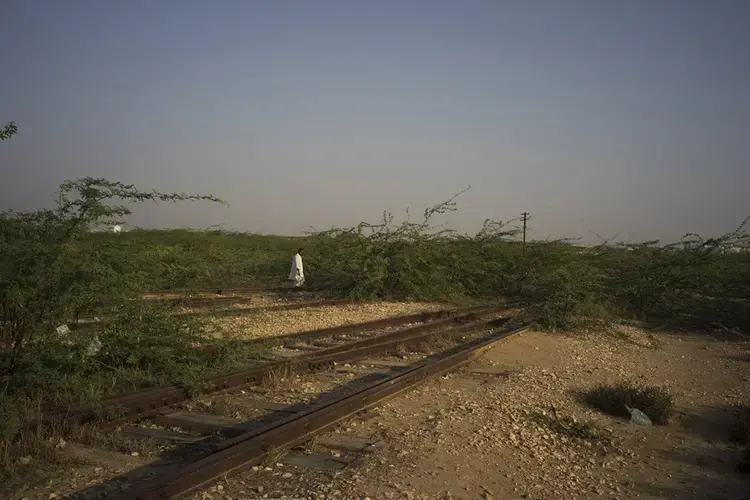
V: There have been moves to re-establish the KCR. Are these efforts gaining ground, and if so, does it signal some progress in the civic life of Karachi?
IS: Ever since KCR closed in 1999, there have been efforts to revive it, and several of those continue today. For years the Pakistani government was in negotiation with Japan’s development agency, JICA, for a several-billion dollar package of infrastructure and capital support to build a contemporary, world-class commuter train.
At the moment the Pakistani government is in negotiation with China for a similar deal, and there are also calls for the railway to be reestablished with existing Pakistani rolling stock, which would be much cheaper. Additionally there are multiple efforts to build bus rapid transit lines, or BRTs, using a range of financing models.
The challenge with many of these proposals is that they require the participation of multiple jurisdictions , and that inevitably causes tensions over authority, control of resources and control of revenue. There are also negotiations and conflicts over the location of stops, the path of the lines, and which businesses and communities might be displaced or benefit. I and many others are hopeful that Karachi will eventually build many of these transport corridors. The commuter train by itself will not solve Karachi’s transport conundrum, but it could be an important element in a multi-modal plan that includes trains, buses, and a support for private systems, from minibuses to three-wheelers.


